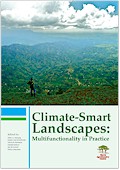| Book Chapter |
 |
|
| Title | Gender-specific spatial perspectives and scenario building approaches for understanding gender equity and sustainability in climate-smart landscapes | | Author | Grace B.Villamor, P. Afiavi Dah-gbeto, Andrew Bell, Ujjwal Pradhan and Meine van Noordwijk | | Editors | Peter A Minang, Meine van Noordwijk, Olivia E. Freeman, Cheikh Mbow, Jan de Leeuw and Delia Catacutan | | Year | 2015 | | Book Title | Climate-Smart Landscapes: Multifunctionality In Practice | | Publisher | World Agroforestry Centre (ICRAF) | | City of Publication | Nairobi, Kenya | | Number of Pages of the book | 16 | | Pages | 211-225 | | Call Number | BC0412-14 |
|
| Abstract: |
| The nexus of gender, land use, landscapes and climate change is very complex and multidimensional.
However, understanding these interactions may reveal important aspects for
achieving food security and improving livelihood resilience to climate change impacts,
especially during extreme events. After all, the concept of the landscape does not merely
refer to a geographic space, but includes the social construct of a ‘theory of place’ based
on diverse cultural and individual perceptions regarding the livelihood (or everyday
life) of individuals and rights of social strata. For many communities in West African
countries, the meaning of landscape is rooted in each persons’ life history and experiences;
and if misread and misunderstood, the landscape is misrepresented (Fairhead & Leach,
1996). Thus, the representation of landscapes should be viewed in combination with an analysis of livelihood dynamics and individual perceptions (e.g., whether the world is
flat or spherical; see Vosniadou, 1994). However, peoples’ perceptions vary according
to their gender and everyday experiences, with the needs of women and men varying
depending on their life phase, social status, income and ethnic origin (Meinzen-Dick
et al., 1997). Gender, as defined by Food and Agricultural Organization of the United
Nations (FAO), is likewise a social construct reflecting both perceptual and material
relations between men and women, including the characteristics and qualities that each
society ascribes with each sex (FAO, 1997); the empirical question of how many gender
strata1 are distinguished is answered differently in different parts of the world. There are
many facets of gender differentiations in roles, responsibilities, options, and decisions
that may affect the delivery of ecosystem services, landscape functionality as well as
environmental sustainability. Yet, there have been few in-depth analyses linking land
use and gender at the landscape level due to inherent complexities (Colfer & Minarchek,
2013; Villamor et al., 2013a) |
|